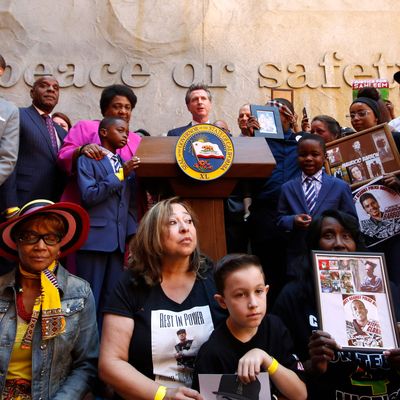
For 147 years, the section of the California penal code outlining when police officers could use deadly force went unaltered. Its parameters were as follows: Police could kill if they were obeying a court judgment, subduing a subject who was resisting the execution of some legal process, or if a subject was fleeing arrest or detainment. It also protected people “acting by [an officer’s] command in their aid and assistance” — essentially allowing the police to deputize others to kill on their behalf. The latter is atypical, of course, and courts have modified their interpretation of the statute over the years. But until this week, it remained the oldest unchanged deadly-force law for police in the country.
That changed on Monday, when Governor Gavin Newsom signed into law Assembly Bill No. 392, which amended both the 1872 law and a corresponding section of the penal code governing the use of force generally, which hasn’t been updated since 1957. Propelled to his desk by backlash against the 2016 Sacramento police shooting of Stephon Clark, an unarmed black man, the bill changes the existing justifiability standard for police: Whereas before, officers could use deadly force if doing so was deemed “reasonable,” the new law requires it to be “necessary in defense of human life.”
What the word “necessary” means here is largely open to interpretation. A previous version of the bill included a definition requiring that, in order to be deployed, “there was no reasonable alternative to the use of deadly force that would prevent death or serious bodily injury to the [police] officer or to another person.” According to Mother Jones, this was excluded from the final version as a concession to police unions, whose support eased its passage. Many activists saw the omission as a major loss — after all, without a clearly established meaning, the word “necessary” has many of the same problems as “reasonable” did before it: Both are, if not totally subject to the shifting standards and whims of those making the determination, much more so than had there been less-vague language about what they actually meant.
Still, the bill is considered a major step forward. “With this new law, California will go from having one of the deadliest, most permissive use of force laws in the country to having one of the strongest,” wrote Jennifer Rojas, a policy advocate for the ACLU of Southern California. This is significant, and certainly for the better: The state saw 115 deadly police shootings in 2018, the most in the nation, and had a higher rate of police killings than all but 12 others. Clark’s death in 2016 sparked protests but also laid bare the extent to which unaccountability has marked local law enforcement. Both Sacramento County District Attorney Anne Marie Schubert and California Attorney General Xavier Becerra declined to file charges against the offending officers after two concurrent yearlong investigations. Any other outcome would’ve been aberrant. According to CNN, citing data compiled by Bowling Green University criminal-justice professor Philip Stinson, just 80 officers nationwide were charged with murder or manslaughter for killing someone while on duty between 2005 and 2017, and only 35 percent of those were convicted.
A.B. 392 marks the latest in a series of criminal-justice reforms California has undertaken of late. In March, Newsom announced a moratorium on the death penalty, effectively guaranteeing that none of California’s 737 death row prisoners — the most of any state — would be killed while he’s in office. It’s the next best thing to banning capital punishment outright, a decision that can only be made by voters, who rejected it in 2012 and 2016. More of a mixed bag was the state’s law ending cash bail, signed in August 2018. Activists ushered the bill to passage, but last-minute alterations pushed by advocates for California’s court system transformed it into something arguably worse than what preceded it. Instead of pretrial detainees being forced to pay money to walk free, the new law gives judges more authority to detain people as they see fit.
All of which illustrates how progress toward a criminal-justice system with less power to ruin or end lives — and do so asymmetrically to black and brown people — is undermined repeatedly by champions of the status quo, both in the electorate and the halls of power. A.B. 392 will inevitably save lives. But it also leaves enough ambiguity to persist in making accountability for officers who kill unjustly a more complicated affair than it should be. The new standard regarding when deadly force is “necessary” remains disconcertingly flexible. But the term’s addition to an archaic statute also adds to the arsenal of reform-minded attorneys. Whether the law meaningfully curbs police violence in California is yet to be seen. But it does narrow the parameters within which killing is justified — even as many still wish it to remain as wide as humanly possible.






























